West Coast Historical Anarchist Media in Print and Online
Newspapers were first published under the black flag on the Pacific Coast over 130 years ago. Blogs, podcasts, and zine distros carry on that work today.
This incomplete list of digitized anarchist publications from the colonized west of the so-called united states makes accessible that long history of insurgent media. Anarchists seeking inspirations and warnings from the past will hopefully find it useful.
Newspapers and magazines from the late-19th and early 20th century chronicle everyday organizing and insurrectionary moments during an era when the West Coast was a major node in a globe-spanning anti-colonial, anti-capitalist anarchist movement. Papers published in several languages from Los Angeles to San Francisco, Portland to Home, Washington were backbones of local networks, sometimes attracting global attention. The various publications below are available in various formats, from PDFs of individual issues to searchable web tools.
There is a dearth of publications from the 1940s until the 1960s; not unexpected given the lull of anarchistic movements in these decades. The revival came in the form of independent and often diy bulletins and newsletters. The 70s witnessed a small proliferation of publications from clandestine prison papers to anarchist comic books to the birth of zine culture.
With the rise of the internet, Indymedia became an early hub building on connections established at the 1999 WTO in Seattle. A network of frequently anonymous, sometimes submission-driven anarchist blogs proliferated in the years that followed. Some of these blogs are still active today, but many old sites remain live and are valuable resources for the interested. There was also several anarchist magazines and newspapers published in Seattle and Tacoma during the late 2000s and 2010s with digitized copies available for reading.
There are undoubtedly publications missing from this list. Old periodicals become lost to time or collect dust in archives or on microfilm. Vibrant anonymous blogs become dead links, occasionally accessible in limited form on the Wayback Machine. One aim of Historical Seditions is to seek out and preserve these. More digitized historic newspapers will be added to our site in the future, and we are always on the hunt for forgotten URLs and PDFs. If you have leads to expand this list, contact us at historicalseditions [at] riseup [dot] net.
A growing, global list of digitized anarchist publications is available at lidiap.ficedl.info
Digitized by Historical Seditions
The Beacon
Kakumei/The Revolution
Free Society & The Firebrand
Storming Heaven
Enfant Terrible
Many more coming soon!
So-Called PNW
The Firebrand – Portland (Or.), 1895-1897
vol. 1, nos. 1, 8, 10, 12-15, 17-22, 24-25, 27-47, 49-52
vol. 2, nos. 2-8, 10-16, 18-19, 21-24, 27, 30-32, 34-52
vol. 3, nos. 1-34
vol. 1, nos. 1, 42
vol. 2, nos. 31-32, 34-45, 47-52
vol. 3, nos. 1-34
Mirror reduced
Discontent – Home (Wash.), 1898-1902
vol. 1, nos. 5, 10, 27, 38, 43, 45, 49-50
vol. 2, nos. 2, 5, 7, 10-14, 43, 48-52
vol. 3, nos. 2-12, 14-20, 22-23, 25-28, 30-43, 46-52
vol. 4, nos. 2-4, 6-13, 15-19, 21-23, 25-31
Clothed with the Sun – Home (Wash.), 1900-1904
vol. 3, nos. 3, 10
vol. 1, nos. 2-3, 10-12
vol. 2, nos. 1-12
vol. 3, nos. 1,3,10
The Demonstrator – Home (Wash.), 1903-1908?
vol. 1, nos. 1-25, 27-31
nos. 1-142
The Industrial Worker – Spokane, Seattle, 1909-1931
vol. 1 – vol. 5
The Agitator – Home (Wash.), 1910-1912
Complete Set
Hammerslag – Seattle, 1911-1912
nos. 1-2, 4
Why? – Tacoma, 1913-1914
Complete Set
Mirror
Mirror
The Dawn – Seattle, 1922-?
vol. 1 nos. 1-8
The Seattle Group Bulletins – Seattle, 1965-1971
no. 1-60 text only
Original Scans
Lilith – Seattle, 1968-1970
nos. 1-3
Earth and Fire – Vancouver, 1972
nos. 1, 2
Revolutionary Anarchist – 1973-?
no. 3
Open Road – Vancouver, 1976-1990
Complete Set
Mirror
Anarchist Black Dragon – Walla Walla, 1978-1983
nos. 2-6, special issue, 8-11
British Columbia’s blackout – Vancouver, 1978-1984?
nos. 1-4, 6, 66, 74-75, 77, 79, 82-85, 91, 109, 117
The Spark: A Newsletter of Contemporary Anarchist Thought – Port Townsend, 1982-1984
nos. 1-5
Ecomedia – Vancouver, 1988-1991?
nos. 1-2, 4-6
nos. 12-21, 23-39, 41-51, 54-69, 72-76, 78-81, 83, 85, 87-92, 94-100
The Insurgent – Eugene, 1991-Present
2010-present issues
New World Disorder – Tacoma, 1992
no. 1
Spontaneous Combustion – Seattle and Portland, 1992
no. 1
NWAC Northwest Anarchist Collective – Seattle, 1992-1993?
nos. 1-2
Anti-Power – Seattle, 1993
no. 1
Black Autonomy: A Journal of Anarchism and Black Revolution – 1994-1997
v. 1 nos. 1-5
v. 2 no. 5
v. 3 nos. 1, 3-5
Crimethinc – Olympia and Elsewhere, 1996-Present
Legacy Article Search: crimethinc.com/library
Parascope – Seattle, 1999?-2000?
no. 4
Indymedia – Seattle, 1999-2013 Portland, 2000-2020
Seattle Wayback Machine
Portland Wayback Machine
Green Anarchy – Eugene, 2000-2008
nos. 5, 7
nos. 6-25
Face to Face with the Enemy – Vancouver, 2004-2007?
facetofacewiththeenemy.wordpress.com
Rad Dad – Portland, 2005-2013
no. 20
Unfinished Business – Portland, 2005
no. 3
A Murder of Crows – Seattle, 2006-2007
nos. 1-2
Prisoner’s Dillema – Seattle, 2006-?
no. 1
CrimethInc. Worker Bulletin – Olympia, 2007
no. 47
no. 47/74
Wii’nimkiikaa – 2007-2010
wiinimkiikaa.wordpress.com
Aint No Party Like a West Coast Party – Olympia, 2008
no. 1
Intersections – Portland and Tacoma, 2008-2009
nos. 1, 4, 5
Pink and Black Attack – Olympia, 2008-2010
nos. 1, 2, 3, 4, 5, 6
Vancouver Anarchist Online Archive – Vancouver, 2009-2010
vanarchive.wordpress.com
The Rebel – Tacoma, 2009
no. 1
Autonomy//253 – Tacoma, 2010-2011
autonomy253.wordpress.com
Magazine Issue 3
nos. 1-5
Lunaria Press – Tacoma, 2010-2011
lunariapress.blogspot.com
Unmanageable Outlaws – 2010-2011
amiableoutlaws.wordpress.com
Continual War – 2010-2012
2010-2011 continualwar.wordpress.com
2011-2012 continwar.noblogs.org
Autonomy Acres – Rural PNW, 2010-2015
autonomyacres.wordpress.com
Tides of Flame – Seattle, 2011-2012
Complete Set
Puget Sound Anarchists – 2011-Present
PugetSoundAnarchists.org (Current Site, 2014-Present)
Wayback Machine (2011-2013)
Warrior Publications – Occupied Coast Salish Territory, Vancouver BC, 2011-Present
warriorpublications.wordpress.com
Gray Coast – Pacific Northwest, 2011-2013
greycoast.wordpress.com
Portland Occupier – Portland, 2011-Present
portlandoccupier.org
BCBlackOut – So-Called British Columbia, 2011-Present
bcblackout.wordpress.com
(A) Wild Harbor – Aberdeen, 2012
awildharbor.wordpress.com
Seattle Free Press – Seattle, 2012-2015
Wayback Machine (2012-2015)
Anarres Press – Seattle, 2013-2015?
anarrespress.wordpress.com
Storming Heaven – Seattle, 2013-2015
nos. 2-6
Warzone Distro – Chicago, Portland, elsewhere – 2013 – Present
warzonedistro.noblogs.org
Outside Agitator (206) – Seattle, 2015-2016
nos. 1-2
Blog Wayback Machine (2015-2016)
Black and Green Review – Salem, 2015-2018
no. 1
The Transmetropolitan Review – Seattle, 2015-2018 (Magazine), 2015-Present (Blog)
nos. 1-6, 7, 8
thetransmetropolitanreview.wordpress.com
Wreck – Vancouver, 2015-2016
Complete Set
Salish Sea Black Autonomists – Olympia, 2017-2020
blackautonomynetwork.noblogs.org
1312press – Seattle, 2018?-Present
Published Zines – 1312press.noblogs.org/1312-published-titles
Rose City Counter-Info – Portland, 2020-Present
rosecitycounterinfo.noblogs.org/
PNW Youth Liberation Front – 2020-2021
pnwylf.noblogs.org/
youthliberation.noblogs.org/
no more city – Vancouver, 2020-2022
2020-20201 Issues – nomore.city/archive
Fugitive Distro – Olympia, 2021-Present
autistici.org/fugitivedistro
Rose City Radical – Portland, 2021-2022
nos. 1-4 rosecityradical.com/past-issues
Sabot Media – Aberdeen, 2021-Present
Blog
Black Cat Distro Zines
The Communique Newsletter nos. 1-3
Creeker – Fairy Creek, Vancouver Island, 2021-Present
vol. 1-4
BC Counter-Information – so-called British Columbia, 2022-Present
bccounterinfo.org
The Occupied West
The Beacon – San Francisco, 1889-1891
vol. 1, nos. 12-13, 15-17
vol. 2, nos. 1-2, 6-8, 18
Egoism – San Francisco, 1890-1897
vol. 1
vol. 2
vol. 3, nos. 1, 18, 23
vol. 4, nos 1-2
Enfant Terrible – San Francisco, 1891-92
nos. 3, 6
Secolo Nuovo – San Francisco, 1894-1906
vol. 7 no. 17
vol. 9 no. 26
Free Society (Sucessor of Portland’s The Firebrand) – San Francisco/Chicago, 1897-1904
vol. 4, no. 1
vol. 5, nos. 31, 34-35, 39-41, 48
vol. 6, nos. 7-21, 24-26, 28-33, 35-58
vol. 7, nos. 1-3, 5, 8, 14-15, 31, 36
vol. 9, nos. 1-52
vol. 10, nos. 19-20, 33, 38, 42, 52
vol. 10b, nos. 1-3, 7-8
Mirror vol. 9
vol. 10, no. 20
Regeneración – Los Angeles and elsewhere, 1900-1901, 1904-1906, 1910-1918
Complete Set
La Protesta Umana – San Francisco and Chicago, 1900-1905
1902-1903
Kakumei/The Revolution – Berkeley, 1906-1907
no. 1
Revolución – Los Angeles, 1907-1908
nos. 1-4, 6-11, 13-17, 19-29
Regeneración. Sezione Italiana – Los Angeles, 1911
Complete Set
Hindustan Ghadar – San Francisco, 1913-192?
Assorted 1913-1917 issues
The Blast – San Francisco, 1916-1917
Complete Set
Man! – San Francisco, 1933-1940
vol. 3, no. 7/8
Now & After – San Francisco, 1977-1978
no. 1
Anarchy Comics – San Francisco, 1978-1987
Complete Set
Slingshot – Berkeley, 1988-Present
nos. 58-137
Anarchist Labor Bulletin – San Francisco (Calif.), 1989?-1990?
nos. 18-19
Willful Disobedience – Los Angeles, 1996-2006
vol. 3, no. 5
vol. 5, nos. 1-2
Ignite! – Denver, 2011-2012
Complete Set
Black Flag – Los Angeles, 2012-2016
Complete Set
Black Seed – Berkeley, 2014 – Present
nos. 1-6
It’s Going Down – Bay Area and Elsewhere, 2015-Present
itsgoingdown.org
2015/Old Legacy Articles via Wayback Machine
Winter-Spring 2016 Print Compilation
Spring 2017 Print Compilation


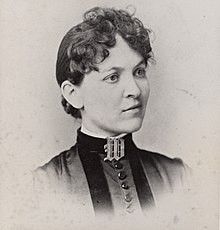 Before the internet wove its globe-spanning web of social media, far-flung groups and individuals were brought together via the print culture of books, pamphlets, newspapers, and journals. The revolutionary culture of the anarchist movement was, in many respects, incubated in the pages of its printed matter. Letters to ones favorite paper often engaged in discourse with one another, bringing correspondents from San Francisco to South Africa to the same playing field. The rapid proliferation and decreasing cost of such publications thus provided more than just a passive window through which to view the world, opening up a new intellectual and social universe.
Before the internet wove its globe-spanning web of social media, far-flung groups and individuals were brought together via the print culture of books, pamphlets, newspapers, and journals. The revolutionary culture of the anarchist movement was, in many respects, incubated in the pages of its printed matter. Letters to ones favorite paper often engaged in discourse with one another, bringing correspondents from San Francisco to South Africa to the same playing field. The rapid proliferation and decreasing cost of such publications thus provided more than just a passive window through which to view the world, opening up a new intellectual and social universe.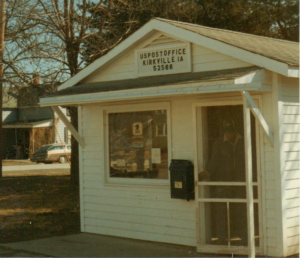 But when she turned 17 (the age of confirmation in her church), Clara instead “stood up and announced that, having lost her belief in the tenants of the church, she was renouncing her membership.
But when she turned 17 (the age of confirmation in her church), Clara instead “stood up and announced that, having lost her belief in the tenants of the church, she was renouncing her membership.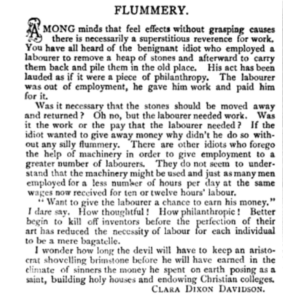
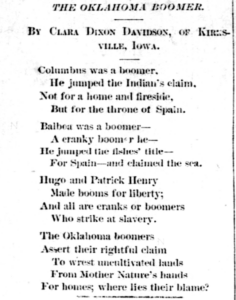 Clara’s poem put a bottom-up spin on the issue, seemingly arguing that settler’s were even more justified in making claims than conquistadors had been; the latter did so on behalf of a crown, the former to find land for homes.
Clara’s poem put a bottom-up spin on the issue, seemingly arguing that settler’s were even more justified in making claims than conquistadors had been; the latter did so on behalf of a crown, the former to find land for homes.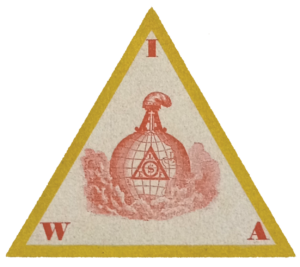 In 1884, letters and poems from Clara appear in Chicago’s Alarm, the English weekly of the “Black” IWPA, as well as the main organs of the IWA, Denver’s Labor Enquirer and San Francisco Truth. By this time Clara clearly counted herself in the radical camp, ending a treatise in the Enquirer advocating for men and women to organize with the famous call:
In 1884, letters and poems from Clara appear in Chicago’s Alarm, the English weekly of the “Black” IWPA, as well as the main organs of the IWA, Denver’s Labor Enquirer and San Francisco Truth. By this time Clara clearly counted herself in the radical camp, ending a treatise in the Enquirer advocating for men and women to organize with the famous call: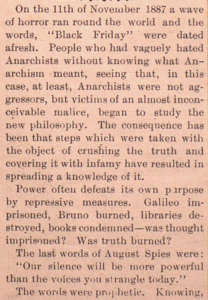 In May, 1886, hundreds of thousands struck demanding the Eight Hour Day across much of the United States. IWPA sections played a significant agitational role in the uprising that witnessed intense clashes between strikers and armed state forces. Most infamously, police murdered several workers outside the McCormick harvester factory in Chicago. Local anarchists responded by calling a mass-meeting at “The Haymarket.”
In May, 1886, hundreds of thousands struck demanding the Eight Hour Day across much of the United States. IWPA sections played a significant agitational role in the uprising that witnessed intense clashes between strikers and armed state forces. Most infamously, police murdered several workers outside the McCormick harvester factory in Chicago. Local anarchists responded by calling a mass-meeting at “The Haymarket.”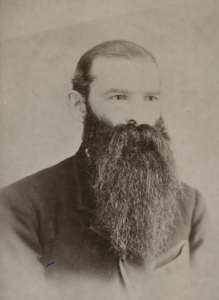 One of the very few opponents was Sigismund Danielewicz, a tireless traveling organizer. Sigismund was the Red International’s Secretary until he spoke out against the anti-Chinese violence, calling for a move to higher principles.
One of the very few opponents was Sigismund Danielewicz, a tireless traveling organizer. Sigismund was the Red International’s Secretary until he spoke out against the anti-Chinese violence, calling for a move to higher principles.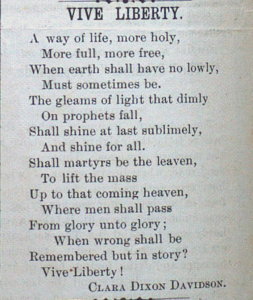 Clara was drawn to San Francisco’s bohemian literary milieu, and her articles and poems from the following decades appear frequently in publications from the Overland Monthly to The Nation. But Clara didn’t rely solely on the good grace of other editors to publish her work.
Clara was drawn to San Francisco’s bohemian literary milieu, and her articles and poems from the following decades appear frequently in publications from the Overland Monthly to The Nation. But Clara didn’t rely solely on the good grace of other editors to publish her work.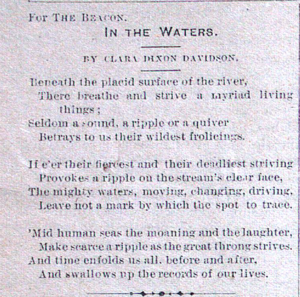
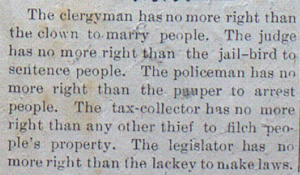 Both surviving issues of Enfant Terrible lead with a poem by Clara before alternating between long sections written by Clara and Harry. Reading from a 21st century vantage it comes off almost like a radical couples blog. Short fables and clever little anecdotes provoke little mental challenges to authority or expose societal hypocrisy. Brief commentary on current events like a proposed law closing business on Sunday reveals Clara and Henry’s distaste for intertwined capital, government, and organized religion.
Both surviving issues of Enfant Terrible lead with a poem by Clara before alternating between long sections written by Clara and Harry. Reading from a 21st century vantage it comes off almost like a radical couples blog. Short fables and clever little anecdotes provoke little mental challenges to authority or expose societal hypocrisy. Brief commentary on current events like a proposed law closing business on Sunday reveals Clara and Henry’s distaste for intertwined capital, government, and organized religion.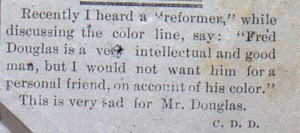 Enfant Terrible was relatively short-lived, its last available issue on December 20, 1891 was only the 6th. The February issue of another local individualist anarchist paper, Egoism, announced its cessation and that subscribers would receive their paper. Egoism’s May issue noted the couple’s participation in debates at the “People’s Free Lyceum” over the meaning of “Philosophical Anarchy.” Henry argued that “majority rule is inexpedient and a social failure because it defeats equal freedom, whereupon it follows that Anarchism is the correct social principle.” Clara delivered her own “sharp hits.”
Enfant Terrible was relatively short-lived, its last available issue on December 20, 1891 was only the 6th. The February issue of another local individualist anarchist paper, Egoism, announced its cessation and that subscribers would receive their paper. Egoism’s May issue noted the couple’s participation in debates at the “People’s Free Lyceum” over the meaning of “Philosophical Anarchy.” Henry argued that “majority rule is inexpedient and a social failure because it defeats equal freedom, whereupon it follows that Anarchism is the correct social principle.” Clara delivered her own “sharp hits.”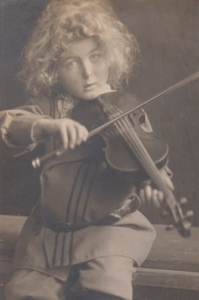 Henry Dixon Cowell was born March 11, 1897; Clara was 46 years old.
Henry Dixon Cowell was born March 11, 1897; Clara was 46 years old.


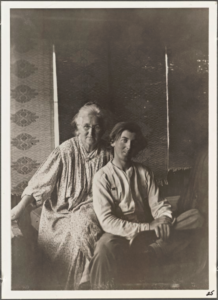 Ellen entered into a tight relationship with the mother-son duo, moving them into her house and later making Henry something of an adopted son and executor of her will. She also helped Henry make musical connections and afford a Steinway piano.
Ellen entered into a tight relationship with the mother-son duo, moving them into her house and later making Henry something of an adopted son and executor of her will. She also helped Henry make musical connections and afford a Steinway piano.







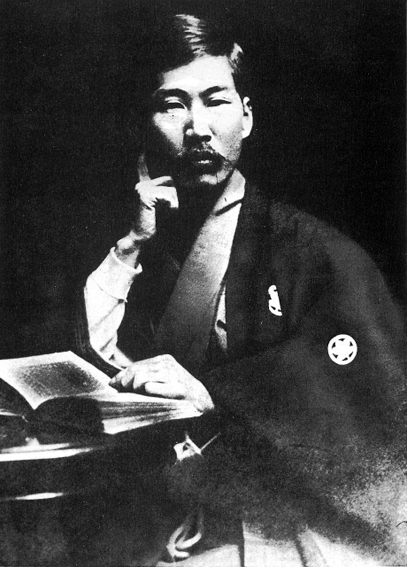
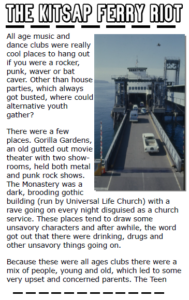 The Kitsap Ferry Riot tells the story of the restrictive old Seattle Teen Dance Ordinance and a punk riot that occurred on the ferry from Bremerton as a result. The text is pulled from the defunct website of a documentary about the riot by Chris Loomey,
The Kitsap Ferry Riot tells the story of the restrictive old Seattle Teen Dance Ordinance and a punk riot that occurred on the ferry from Bremerton as a result. The text is pulled from the defunct website of a documentary about the riot by Chris Loomey, 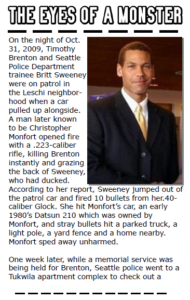 The Eyes of a Monster is the tale of Chris Monfort. Appalled by police brutality in his community, Chris looked the monster in the eye and refused to blink. He launched a one-man war against Seattle Police in 2009, bombing vehicles and killing one SPD officer in an ambush. Chris mysteriously died in Walla Walla State Penitentiary in 2017. (3 sheets letter)
The Eyes of a Monster is the tale of Chris Monfort. Appalled by police brutality in his community, Chris looked the monster in the eye and refused to blink. He launched a one-man war against Seattle Police in 2009, bombing vehicles and killing one SPD officer in an ambush. Chris mysteriously died in Walla Walla State Penitentiary in 2017. (3 sheets letter)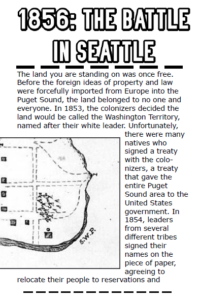 1856: The Battle in Seattle is the tale of Chief Leschi, the Nisqually, and other warriors who fought to expel the settler-colonial leviathan in its infancy. (2 sheets letter)
1856: The Battle in Seattle is the tale of Chief Leschi, the Nisqually, and other warriors who fought to expel the settler-colonial leviathan in its infancy. (2 sheets letter)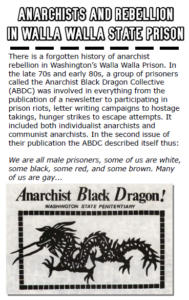 Anarchists and Rebellion in Walla Walla State Prison is an account of the Anarchist Black Dragon, an imprisoned anarchist collective who published an underground newspaper and helped spur several prisoner uprisings. (1 sheet letter)
Anarchists and Rebellion in Walla Walla State Prison is an account of the Anarchist Black Dragon, an imprisoned anarchist collective who published an underground newspaper and helped spur several prisoner uprisings. (1 sheet letter)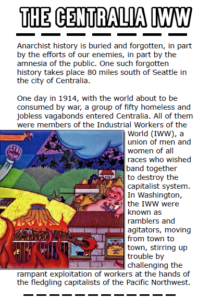 The Centralia IWW tells of the lumberjacks and hobos who organized a revolutionary union in this small Washington town. The intense repression they faced culminated in the so-called Centralia Tragedy in 1919. (2 sheets letter)
The Centralia IWW tells of the lumberjacks and hobos who organized a revolutionary union in this small Washington town. The intense repression they faced culminated in the so-called Centralia Tragedy in 1919. (2 sheets letter) The Dude Smashed the Federal Courthouse, Too! recalls the nationwide uprising in 1970 over the trial of Black Panther Bobby Seale and the Chicago Seven. The rowdiest solidarity action occurred in Seattle, where the federal courthouse was smashed. One of the most famous arrestees was Jeff Dowd, inspiration for “The Dude” in “The Big Lebowski” (1 sheet letter)
The Dude Smashed the Federal Courthouse, Too! recalls the nationwide uprising in 1970 over the trial of Black Panther Bobby Seale and the Chicago Seven. The rowdiest solidarity action occurred in Seattle, where the federal courthouse was smashed. One of the most famous arrestees was Jeff Dowd, inspiration for “The Dude” in “The Big Lebowski” (1 sheet letter)